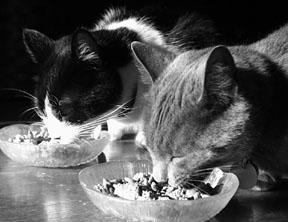If switching your cats food is warranted, be sure to do it gradually. For any number of reasons, you may feel that your cat could do well with a change in diet. If thats the case, contact your cats veterinarian for advice. Find out if switching foods is indeed necessary and will truly benefit your animals overall health. If your veterinarian recommends a diet change, you should make the switch gradually so that the cats digestive system can properly adjust to the new food.
Its good to offer your cat a bit of variety within each meal, says Ilona Rodan, DVM, director of the Cat Care Clinic in Madison, WI. You can accomplish that by mixing two foods that have different shapes and sizes, or by blending canned and dry food. That will help prevent the animal from becoming fixated on one specific type of food, which is important in case a diet change is needed for medical reasons later in the animals life. Otherwise, Dr. Rodan says, cats dont really need more variety than that, and change merely for the sake of change is unnecessary.
In fact, to go one week on one diet and another week on another diet is difficult for their systems, says Dr. Rodan. If you take your cat on vacation with you, she adds, dont assume that youll find her usual brand of food during your travels. Call ahead to local veterinary hospitals or pet stores to see if they carry your cats food, she advises. Or just take a supply of your cats food with you.
Reasons for Change
Unfortunately, many cats have been eating lower-quality brands of food by the time they visit our clinic, says Dr. Rodan. A lot of these foods are not the best for preventing future health problems. She cites dental health as one of the very good reasons for changing foods, since periodontal disease is the number one disease among young adult cats.

288
Dr. Rodan cites several additional good reasons for changing a cats diet. For example, pregnant or lactating cats should be fed a food of higher calories with more protein. Cats with chronic renal disease should consume a kidney-friendly diet that contains more potassium and less phosphorous. Obese cats may need to switch to low-calorie foods. And cats with urinary tract problems are likely to benefit by a switch from dry food to canned food, which contains more moisture.
If your cat is not eating her food, you should see your veterinarian to find out why and to determine whether a change is needed, says Dr. Rodan. Most cats arent just being finicky. Your cat may have a serious health problem that is causing her to reject her food.
Switching Safely
To prevent digestive problems or other negative reactions, any switchover in diet should be made by gradually increasing the new food and decreasing the old. In most situations, says Dr. Rodan, the change should be done over a seven to 10 day period so that its easier for the cats digestive system to accept. If the change is made too rapidly, the cat may experience diarrhea or vomiting – the new food just isnt what shes used to.
In most cases, a cat will experience no problematic digestive reactions to a new diet that is presented gradually. Some cats, though, will protest the change and wont eat, says Dr. Rodan. If thats the case, step back and introduce the new diet even more gradually, with smaller amounts of the new food added each day. If the cat still wont eat the new diet, call your veterinarian for further recommendations.



